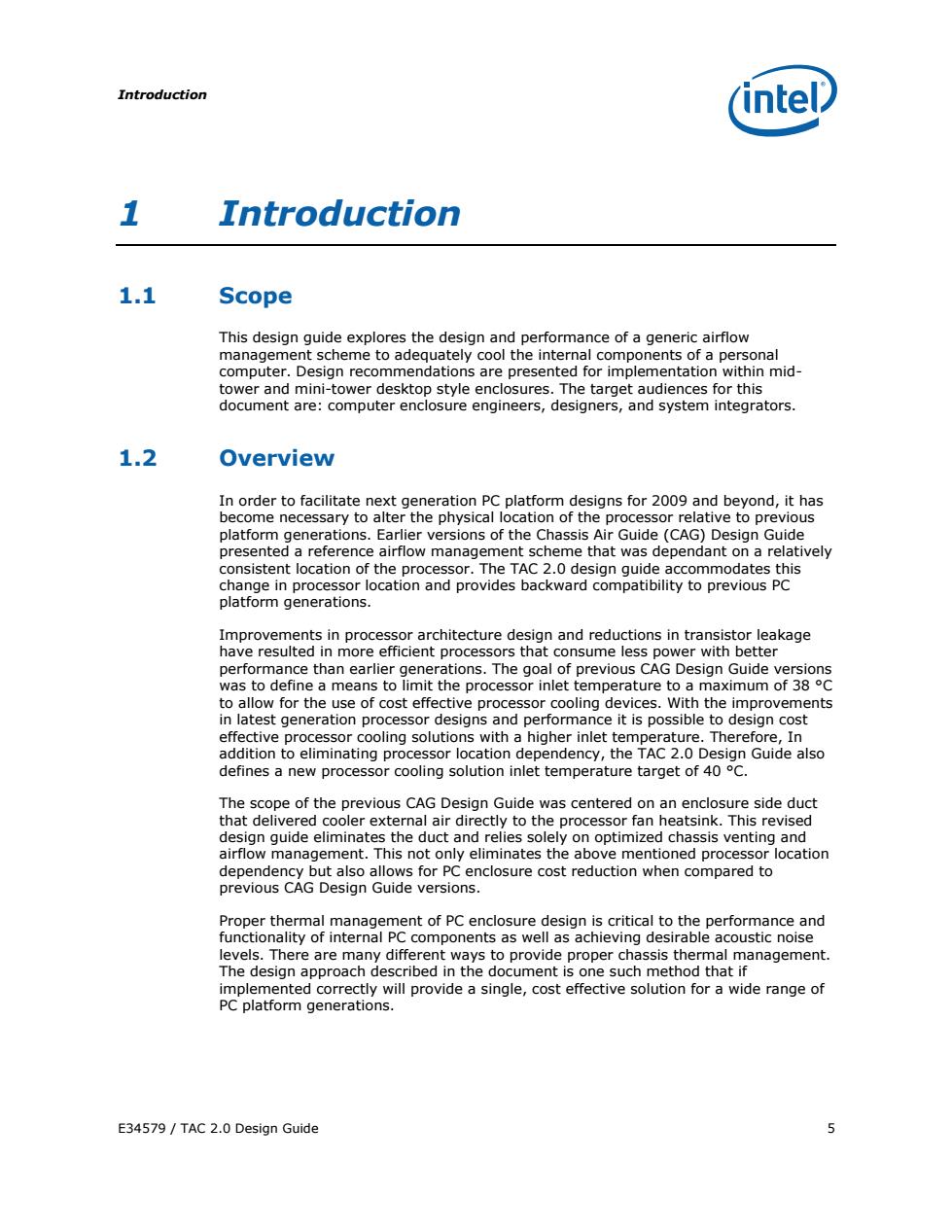正在加载图片...

Introduction intel 1 Introduction 1.1 Scope This design guide explores the design and performance of a generic airflow management scheme to adequately cool the internal components of a personal computer.Design recommendations are presented for implementation within mid- tower and mini-tower desktop style enclosures.The target audiences for this document are:computer enclosure engineers,designers,and system integrators. 1.2 Overview In order to facilitate next generation PC platform designs for 2009 and beyond,it has become necessary to alter the physical location of the processor relative to previous platform generations.Earlier versions of the Chassis Air Guide(CAG)Design Guide presented a reference airflow management scheme that was dependant on a relatively consistent location of the processor.The TAC 2.0 design guide accommodates this change in processor location and provides backward compatibility to previous PC platform generations. Improvements in processor architecture design and reductions in transistor leakage have resulted in more efficient processors that consume less power with better performance than earlier generations.The goal of previous CAG Design Guide versions was to define a means to limit the processor inlet temperature to a maximum of 38 C to allow for the use of cost effective processor cooling devices.With the improvements in latest generation processor designs and performance it is possible to design cost effective processor cooling solutions with a higher inlet temperature.Therefore,In addition to eliminating processor location dependency,the TAC 2.0 Design Guide also defines a new processor cooling solution inlet temperature target of 40 C. The scope of the previous CAG Design Guide was centered on an enclosure side duct that delivered cooler external air directly to the processor fan heatsink.This revised design guide eliminates the duct and relies solely on optimized chassis venting and airflow management.This not only eliminates the above mentioned processor location dependency but also allows for PC enclosure cost reduction when compared to previous CAG Design Guide versions. Proper thermal management of PC enclosure design is critical to the performance and functionality of internal PC components as well as achieving desirable acoustic noise levels.There are many different ways to provide proper chassis thermal management. The design approach described in the document is one such method that if implemented correctly will provide a single,cost effective solution for a wide range of PC platform generations. E34579/TAC 2.0 Design Guide 5Introduction E34579 / TAC 2.0 Design Guide 5 1 Introduction 1.1 Scope This design guide explores the design and performance of a generic airflow management scheme to adequately cool the internal components of a personal computer. Design recommendations are presented for implementation within midtower and mini-tower desktop style enclosures. The target audiences for this document are: computer enclosure engineers, designers, and system integrators. 1.2 Overview In order to facilitate next generation PC platform designs for 2009 and beyond, it has become necessary to alter the physical location of the processor relative to previous platform generations. Earlier versions of the Chassis Air Guide (CAG) Design Guide presented a reference airflow management scheme that was dependant on a relatively consistent location of the processor. The TAC 2.0 design guide accommodates this change in processor location and provides backward compatibility to previous PC platform generations. Improvements in processor architecture design and reductions in transistor leakage have resulted in more efficient processors that consume less power with better performance than earlier generations. The goal of previous CAG Design Guide versions was to define a means to limit the processor inlet temperature to a maximum of 38 °C to allow for the use of cost effective processor cooling devices. With the improvements in latest generation processor designs and performance it is possible to design cost effective processor cooling solutions with a higher inlet temperature. Therefore, In addition to eliminating processor location dependency, the TAC 2.0 Design Guide also defines a new processor cooling solution inlet temperature target of 40 °C. The scope of the previous CAG Design Guide was centered on an enclosure side duct that delivered cooler external air directly to the processor fan heatsink. This revised design guide eliminates the duct and relies solely on optimized chassis venting and airflow management. This not only eliminates the above mentioned processor location dependency but also allows for PC enclosure cost reduction when compared to previous CAG Design Guide versions. Proper thermal management of PC enclosure design is critical to the performance and functionality of internal PC components as well as achieving desirable acoustic noise levels. There are many different ways to provide proper chassis thermal management. The design approach described in the document is one such method that if implemented correctly will provide a single, cost effective solution for a wide range of PC platform generations